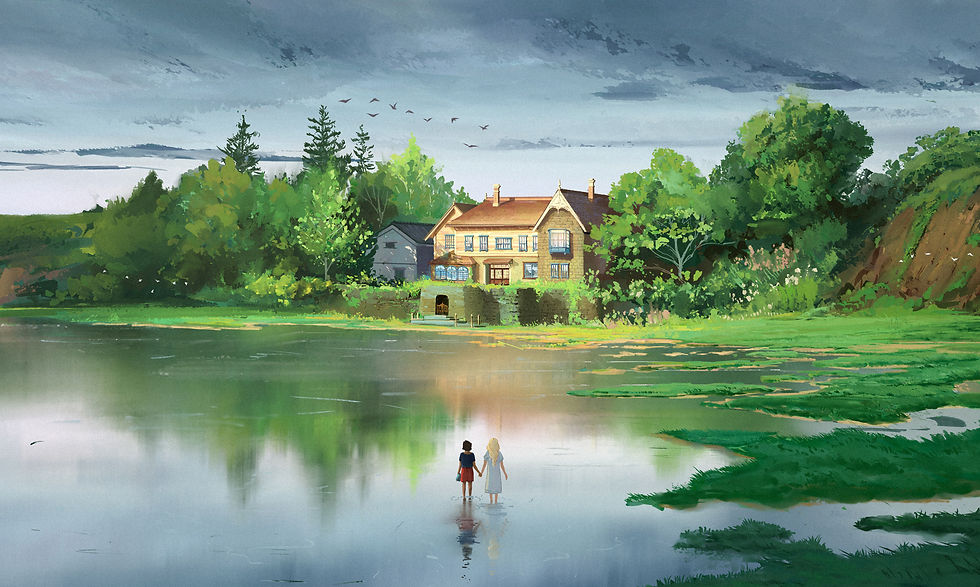When Marnie Was There (2014)
- John Cajio

- Mar 31
- 4 min read
Recently, I rewatched Arrival, the excellent science-fiction film by Denis Villeneuve. At first glance, it would not seem that Arrival and When Marnie Was There, the 2014 film by acclaimed animation Studio Ghibli, would share much of anything in common. And yet, they clearly share the same structural linchpin that ties each film together. There’s a good chance that, as you're drawn into the film by its arresting visuals, interesting characters, and excellent performances, that you may spend a good chunk of the film’s 103-minute run time wondering what the heck is going on. And, just as Villeneuve executes so well in Arrival, Director and Co-Writer Hiromasa Yonebayashi ties everything together in the film’s closing minutes with a finely made bow. Crucially, he does not hold your hand as he does so.
When Marnie Was There tells the story of a young girl, Anna (Sara Takasuki/Hailee Steinfeld), an asthmatic girl with poor self esteem gifted with a strong talent for drawing. After a particularly bad asthma attack, her foster mother, Yoriko Sasaki (Nanako Matsushima/Geena Davis), sends her to a rural seaside town to live with her laissez-faire relatives, Kiyomasa and Setsu Oiwa (Susumu Terajima/John C. Reilly and Toshie Negishi/Grey Griffin respectively), for the summer. While there, an old marsh house catches her attention. It’s not long before she meets the titular Marnie (Kasumi Arimura/Kiernan Shipka). The two girls instantly hit it off.
When Marnie Was There is an absolute feast for the eyes. The quaint and picturesque seaside village is imbued with life in every scene. There is always a little something happening in the background of the scenes that don’t involve Marnie (important to note). Whether it’s someone rounding a corner on a bicycle, or walking in Anna’s opposite direction, or in a brilliant choice, two young people having an intimate conversation in the background at a town festival as Anna runs away with tears streaking her face in a juxtaposition of emotions. The environments are varied and masterfully drawn and animated. There are a number of wide shots of the salt marsh and its environs, including of the old marsh house, that are arrestingly gorgeous. One could press the pause button and find an endless amount of detail in the image, as if it was painted by one of the great masters. My traditional complaint with Studio Ghibli films whenever there is motion from the hand-drawn and the computer-generated imagery continues. Those issues are still present in When Marnie Was There. The CGI tends to be too smooth in comparison to the hand-drawn elements, and I find it a distraction. However, there are fewer instances of it in this film, and they are shorter in duration.
The characters feel human and alive, and seem to have real, human motivations. Anna struggles to make friends and is embarrassed easily, but bonds quickly with Marnie because Marnie seems to accept her early on for who she is. Like Anna, Marnie is also lonely, but she hides it under a guise of false confidence and jubilance. The Oiwa’s, the folks that Anna is staying with, take a very hands-off approach to how they parent Anna, which seems to be in contrast to Yoriko, her foster mother. Early on, Anna asks permission to leave the house and tells them precisely where she is going. Setsu cuts her off and tells her to be safe and to have a great time, even as Kiyomasa is pointing out a nearby shortcut for her to use. Anna’s hesitation at the response speaks volumes. It’s not long, however, before Anna rushes out of the house shouting that she’ll be back later. But that’s not to say the Oiwa’s don’t care about Anna; it’s clear they care deeply about her. When some new characters join the film’s second half to shake things up, they do so in a way that’s totally believable and critically important to the progression of the film’s story.
The music in a Studio Ghibli film is usually highlight for me, and that’s generally the case here. Composer Takatsugu Muramatsu provides a score here that is full of heart, pathos, and elements of mysticism. It’s quite strong—especially the piano writing. However, there is a recurring theme throughout the film that lacks the depth and the weight needed to carry the elements of the film it is expected to carry. Critically, this same theme does not receive much development; in fact we hear it several times in precisely the same orchestration and arrangement.
Overall, When Marnie Was There is a delight to behold. Full of heart, full of wonderful images, solid music, and a terrific story if you have the patience to allow it to unfold. When Marnie Was There is a film that does not suck.
Directed by Hiromasa Yonebayashi.
Written by Masashi Andō, Keiko Niwa, and Hiromasa Yonebayashi.
Starring Sara Takasuki/Hailee Steinfeld, Kasumi Arimura/Kiernan Shipka, Susumu Terajima/John C. Reilly, Toshie Negishi/Grey Griffin, Nanako Matsushima/Geena Davis, etc.
7.5/10 = WORTH RENTING OR BUYING (IT DOES NOT SUCK)





Comments